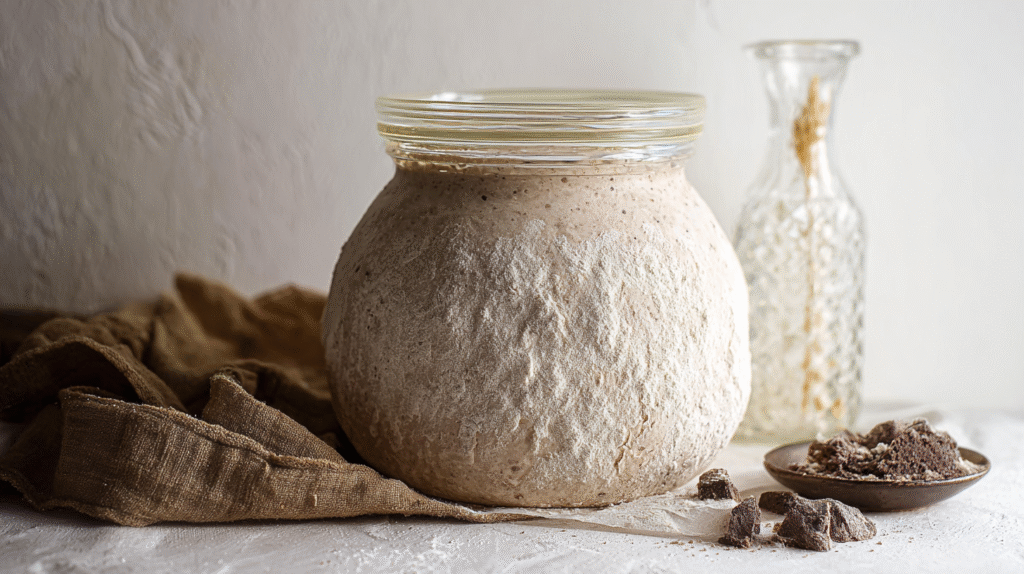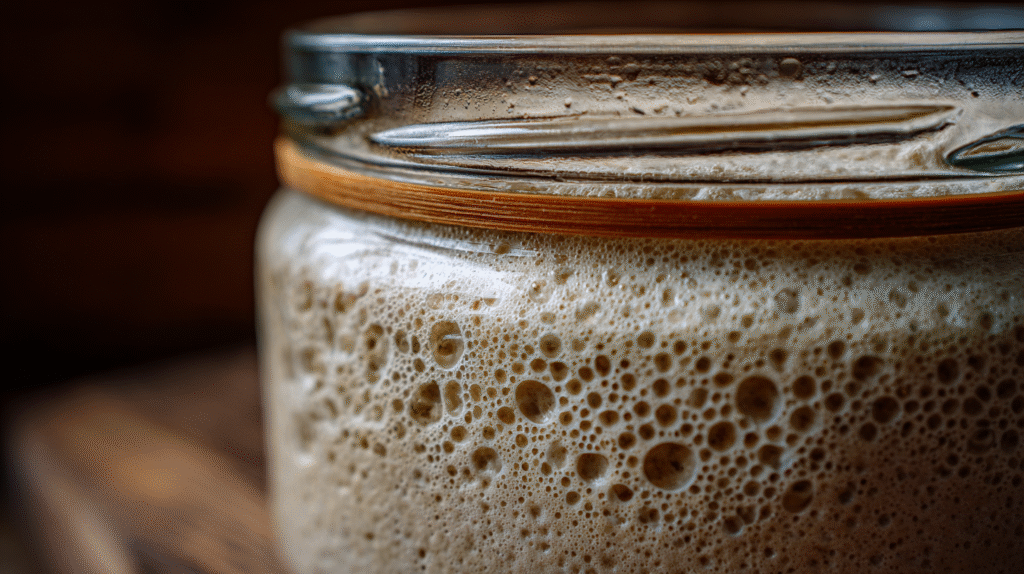If you’re tired of tossing cups of flour into the trash and dreading the daily feeding schedule, this no discard sourdough starter recipe is for you. I’ll walk you through a completely waste-free, beginner-proof method called the “scrapings method”—a low-maintenance, reliable approach that changed the way I bake and made sourdough a joy, not a chore.

The Starter You’ll Never Throw Away
When I first started baking with sourdough, I followed all the advice. I fed my starter religiously, discarded half of it every day, and still couldn’t get consistent results. Then one day, I paused and asked: Why am I wasting so much flour? That question led me down a path of testing, adjusting, and eventually creating a no discard sourdough starter recipe that actually works.
The secret is the scrapings method. Instead of building a huge starter that demands daily attention and wasteful discard, this method uses a tiny bit of dough (just the leftover scrapings in your jar) and only feeds when needed. It’s a true game-changer for home bakers—and especially perfect for anyone who bakes once or twice a week.
Using this approach, you’ll feed only what you plan to bake with. You’ll keep a minimal starter in your fridge, ready to wake up when you need it. No more stress, no more waste—and it works beautifully with all types of flour, especially rye, which is the best choice for beginner resilience.
What Makes This Method Work (Even for First-Timers)
The key to this no discard sourdough starter recipe is twofold:
- Precision. You’ll need a digital kitchen scale. Measuring by weight (in grams) isn’t optional it’s a necessity. Even small variations in flour or water can shift the balance of your starter. A scale makes it exact every time.
- Flour choice. Rye flour gives your starter a strong, fast start. It’s full of nutrients and natural yeasts, and unlike all-purpose flour, it creates a bubbly culture more quickly and consistently. If you don’t have rye, whole wheat flour is your next best bet. Avoid bleached or overly processed flours for your first batch.
With this method, you won’t just make a starter—you’ll build confidence. Over the next few days, I’ll walk you step-by-step through what to do, what to look for, and how to troubleshoot. By the end, you’ll have a thriving, no-fuss, no discard sourdough starter recipe that’s ready to power bread, pizza, pancakes, and more.
Up next, I’ll guide you through the exact tools, flour types, and daily starter schedule you need to begin. Trust me—it’s simpler than you think.
Ingredients, Tools, and Exact Steps (No Discard Sourdough Starter Recipe!)
What You Need to Get Started (Tools + Ingredients)
Before you begin your no discard sourdough starter recipe, gather everything in one place. Simplicity is the point—but precision matters.
Here’s what you need:

| Item | Details |
|---|---|
| Digital Kitchen Scale | Accuracy to 1 gram is essential—skip the cups. |
| Flour | Start with rye flour or whole wheat. Avoid bleached flour. |
| Water | Filtered or dechlorinated, room temperature. |
| Clean Glass Jar | 16 oz or larger, with a loose lid or cloth cover. |
| Rubber Band (optional) | To track starter rise day-by-day. |
The 7-Day Sourdough Starter Guide (No Waste!)
Now, let’s walk through the complete no discard sourdough starter recipe method, one day at a time. Each day, you’ll feed your starter once, and by Day 7, you’ll be ready to bake.
Day 1
- In a clean jar, mix 25g rye flour + 25g filtered water
- Stir well, scrape the sides, and cover loosely
- Store at room temperature (68–75°F ideal)
Day 2
- Stir the starter—no feeding yet
- You may see a few bubbles. That’s normal.
Day 3
- Feed: Add 25g flour + 25g water
- Mix thoroughly, cover again
- By evening, you may see more bubbles or smell sourness
Day 4
- Repeat feeding: 25g flour + 25g water
- The starter may rise after feeding, then fall—this is a “false start” surge. Totally normal.
Day 5
- Stir, observe. Bubbles and sour aroma should intensify
- Feed again only if you’re baking tomorrow; otherwise, wait
Day 6
- At this stage, the starter may double in volume
- If not, don’t panic. Continue one more day
Day 7
- If bubbly and slightly spongy, your starter is ready
- You can now refrigerate the scrapings and feed only when baking

Using and Maintaining Your No Discard Starter
How to Bake with Your Starter (Without Extra Waste)
Now that your starter is active and alive, you’re ready to use it. The beauty of this no discard sourdough starter recipe is that you never have to throw away flour again. Instead of keeping a large, constantly-fed jar, you simply use what you need—then store the leftover “scrapings” until next time.
Suppose your recipe requires 100 grams of starter
- The night before baking, take your starter jar out of the fridge.
- Use a spoon to remove the scrapings from the jar (you need only about 5g of starter).
- In a clean bowl, mix:
- 5g starter
- 50g filtered water
- 50g flour (preferably the same one you started with)
- Stir well and let it sit loosely covered at room temp overnight.
- In the morning, your bubbly, active starter is ready to go.
Once you’ve taken what you need, transfer a tablespoon of the remaining active starter into a clean jar. That’s your new “base” no discard needed.
It’s simple, efficient, and it keeps your starter strong. Whether you’re baking sourdough bread or using it in a weekend treat like dinner recipes, this method scales with your needs.
Maintenance for Any Baking Frequency
One of the best features of this approach is how easily it adapts to your baking habits.
If you bake weekly:
- Store the jar of scrapings in the fridge
- Feed your starter the night before baking, maintaining the 1:10:10 ratio.
- Return scrapings to fridge afterward
If you bake less often (every 2–4 weeks):
- Remove it from the fridge every 2–3 weeks and give it a feeding to keep it active.
- Freeze a backup portion in case of long gaps
To freeze your starter:
- Spread a tablespoon of fully active starter on parchment
- Dry it overnight and store in an airtight jar or zip bag
- When ready, rehydrate with warm water and feed like new
With this schedule, there’s zero waste, minimal effort, and total flexibility—no matter how often you bake.
Bonus – Bake Your First No-Knead Loaf
Now that your no discard sourdough starter recipe is strong and ready, it’s time to make your first loaf no kneading, no stress. This method uses high hydration for an open crumb and a crunchy crust with very little hands-on work.
Here’s the full recipe:
Ingredients
100g active sourdough starter (from your overnight feed)
350g filtered water (room temperature)
500g bread flour (or a mix of 400g bread + 100g whole wheat)
10g fine sea salt
Steps
- Combine the starter and water in a large bowl, mixing until the mixture turns cloudy.
- Add flour and stir to form a shaggy dough.
- Cover and let rest 45 minutes (this is called “autolyse”).
- Sprinkle in salt, and fold the dough gently to incorporate.
- Cover again and let rest for 4–5 hours at room temperature. Every hour, perform a simple stretch and fold—grab the edge of the dough and fold it over itself, turning the bowl as you go.
- After the bulk rise, transfer dough to a floured surface. Shape gently into a round.
- Transfer to a proofing basket dusted with flour or a bowl lined with a floured towel. Cover and refrigerate overnight.
- The next day, preheat oven to 475°F with Dutch oven inside.
- Flip dough onto parchment paper, score the top, and carefully place into hot Dutch oven.
- Bake covered 25 minutes, then uncover and bake 20 more until golden.
This loaf is rustic, chewy, and flavorful. It’s the ideal first project and proof that this method works. You can confidently experiment with breakfast recipes next—sourdough waffles, pancakes, and muffins all benefit from this same starter.
Serving, Storage, and Flavor Tweaks
Serving ideas:
- Pair slices with soup, olive oil, or honey butter
- Toast and top with avocado, eggs, or seasonal jam
- Use for sandwiches, bruschetta, or grilled cheese
Storage:
Store cut-side down on a wooden board for up to 24 hours
For longer storage, wrap in a clean towel or freeze sliced
Flavor Add-ins:
Mix in rosemary, roasted garlic, or sesame seeds before the bulk rise
Add dried cranberries and walnuts for a sweet version
Or go classic with poppy seeds and sea salt on top
Your first loaf is just the beginning. With this easy process, you can adapt, explore, and build your confidence one bake at a time without ever discarding a gram of flour.
Table of contents
Table of Contents
Can I feed my sourdough starter without discarding?
Yes! That’s the core of this no discard sourdough starter recipe. Instead of maintaining a large amount of starter, you keep a small bit in the fridge and only feed what you need for your next bake. No discard required.
How do I prevent sourdough discard in general?
Use the scrapings method: always store a small amount (just the leftovers) and feed it only when you plan to bake. This lets you scale up without wasting flour and prevents the constant maintenance of a large jar.
How can I substitute sourdough discard in other recipes?
If you do end up with some excess, use it in pancakes, crackers, waffles, or dessert recipes. Replace up to ½ cup of flour and water in recipes with equal weight of discard for a tangy boost.
Is sourdough discard just unused starter?
Yes—discard is the portion of starter you remove before feeding to control size. In this method, you avoid that entirely by never building a large starter to begin with.
My sourdough starter isn’t bubbly. What should I do?
Give it more time. Temperature, flour type, and water quality all affect activity. Rye flour and filtered water can help speed up fermentation. If it smells pleasant but isn’t rising, it’s still alive—just be patient.
Conclusion
This no discard sourdough starter recipe proves that baking bread from scratch doesn’t need to be fussy, time-consuming, or wasteful. By using the scrapings method, you eliminate flour waste, simplify your baking rhythm, and get a resilient, reliable starter that’s always ready when you are.
Whether you bake every week or once a month, your starter can adapt. And with the included no-knead loaf, you’re already equipped to turn your new starter into delicious results.
There’s nothing quite like the feeling of slicing into your first crusty sourdough, knowing you didn’t waste a single gram to get there. So feed your starter, feed your creativity—and don’t throw anything away.







